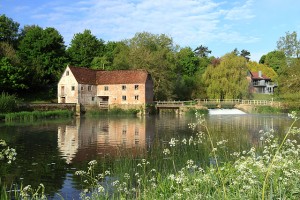Last Sunday Chap and I headed south into Dorset. We wanted to visit the Fippenny Fair at Okeford Fitzpaine, but as that didn’t start until 2 we decided to take an amble en route. We stopped at Sturminster Newton Mill on the River Stour, with a view to doing a riverside walk, but to our delight found that the Mill was open, and not only that, it was one of its milling days. So in we went, paying our very reasonable entrance fee of £2.50 each.
The history of the Mill can be traced back for nearly 1,000 years, as it is almost certainly one of the four mentioned at Sturminster Newton in the Domesday Book of 1086. There may well have been a Saxon or even a Romano-British mill on the site before this. For most of its life the Mill was powered by two undershot water wheels working side by side; in 1904 these were replaced by a single water turbine, mounted horizontally under the water, which drove three pairs of stones. The Mill produced both flour and animal feed. It is owned by the Pitt-Rivers Estate, and was in constant use until 1970, when the last miller left and the Mill was boarded up and left abandoned for ten years. In the 1980s a Mill Trust was formed and several tenant millers worked there over the next decade. In 1994 it was decided to run the Mill as a visitor attraction, managed by the Sturminster Newton Museum and Mill Society, a volunteer-run organisation.
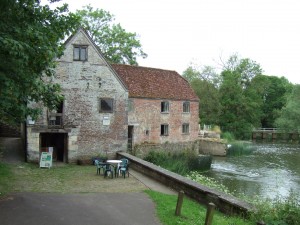
Sturminster Newton Mill on the River Stour. South wing (flour mill) to the left and north wing (originally a separate fulling mill) to the right.
We were taken on a guided tour of the entire building, and all the while the turbine was powering various machines and of course the millstones. The whole building gently shook, and the air thrummed to the regular pulse of the machinery. Canvas drive belts span, flour was pouring down shutes made of old-fashioned ticking and hessian, and chaff floated lightly about in the air, like drifting snowflakes. The homely smell of freshly-ground corn (grain such as wheat, rye, and barley to transatlantic readers) was all-pervasive. It is a magical place, and a real time warp—just as if the last hundred years had never happened. On the ground floor is the meal floor; above that is the stone floor where the grinding was done, and on the top floor is the bin loft where the grain was stored prior to grinding.
The mill is an L-shaped building. The south wing is the flour mill, and the present building was rebuilt c. 1650, presumably on the site of/incorporating parts of an earlier building. We were told that one of the trusses in the roof has recently and tentatively been dated by architectural historians to c. 1350! The north wing was ‘originally a completely separate fulling mill, built in 1611, then demolished in the late 18th century and rebuilt in brick on its original stone base to join with and extend the grain mill’, so the Mill’s website explains.
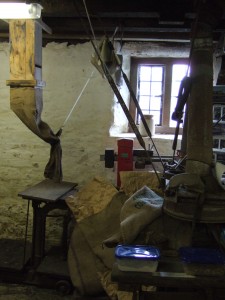
Machinery on the meal floor of the Mill: ground corn in the form of flour arriving from the floor above.
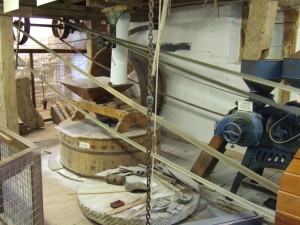
Machinery on the stone floor of the Mill. The pair of millstones are protected under the wooden vat or tun on the left.
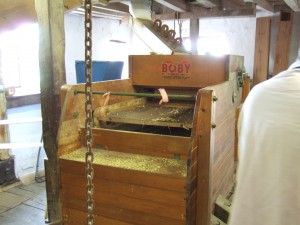
Winnower in action on the stone floor.
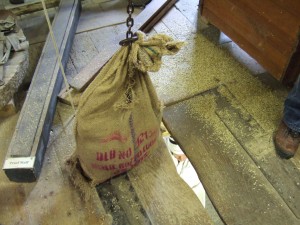
Bag of grain (on its way to the bin loft) arrived on the stone floor via the hoist through a well-worn trapdoor. Miller visible on the meal floor below.
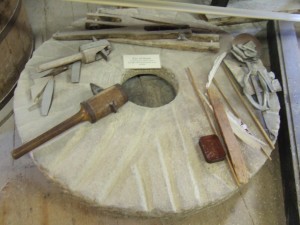
Millstone with tools to dress it when it had worn down too much.
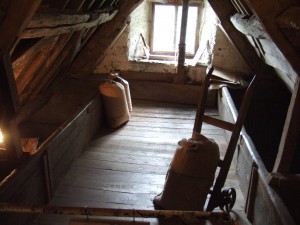
Bins for grain in the bin loft at the top of the Mill. The roof truss that possibly dates from c. 1350 is visible up against the gable wall.
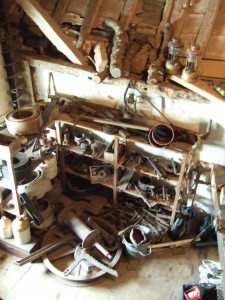
Miller’s workshop in the other (north) wing of the Mill.
We were able to buy some of the flour that had been ground that day and I’m really looking forward to baking with it. (Update: you can see how I got on with a recipe for wholemeal bread made with this flour here).
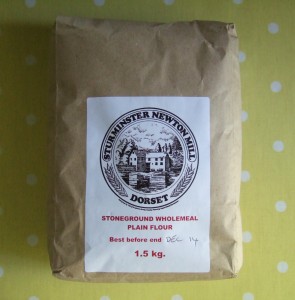
Flour from the Mill.
The Mill is open until 29 September on Mondays, Thursdays, Saturdays and Sundays from 11 am—5 pm. Admission for adults is £2.50 and for children is £1.00.
According to the leaflet we picked up, the special milling weekends this year are on
12 and 13 July, 11 am—5 pm
9 and 10 August, 11 am—5 pm
13 and 14 September, 11 am—5 pm
and the same entrance fees are charged. It’s well worth a visit. The stairs are very steep, so only the ground floor is suitable for those with limited mobility. There is a picnic area at the back of the Mill where you can sit and watch the river.
A big ‘thank-you’ to the great volunteers who work there and who made our visit such a joy. It really is a very special place indeed.
I have looked to see if the Mill has been used as a location for films or television programmes, but can’t find anything. It certainly would make an exceptional location for a period production as it is so untouched by the 21st century (and barely by the 20th!).
Sturminster Newton Museum and Mill Society website link. Also used as a source: Sturminster Newton Mill, by Peter Loosmore and Roy Clarke, 2010 (2nd edition), published by Sturminster Newton Museum and Mill Society.
